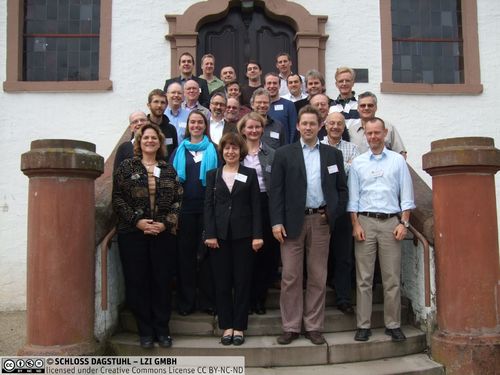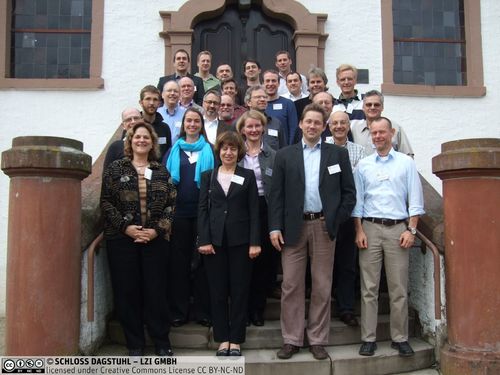Dagstuhl-Seminar 11441
Science and Engineering of Cyber-Physical Systems
( 01. Nov – 04. Nov, 2011 )
Permalink
Organisatoren
- Holger Giese (Hasso-Plattner-Institut - Potsdam, DE)
- Bernhard Rumpe (RWTH Aachen, DE)
- Bernhard Schätz (fortiss GmbH - München, DE)
- Janos Sztipanovits (Vanderbilt University, US)
Kontakt
- Simone Schilke (für administrative Fragen)
Programm
Today, a new category of engineering systems is emerging that combines physical processes with computational control in a holistic way: Cyber-physical systems (CPS). Cyber Physical Systems are engineered systems of synergistically interacting physical and computational components. The key property of these systems is that functionality and salient system properties are emerging from an intensive interaction of physical and computational components. As the computational components are aware of their physical context, they are intrinsically distributed, (time)-synchronizing, have to cope with uncertainty of sensoric-input and need to produce real-time reactions. Consider an unmanned aerial vehicle (UAV) with active wings. In such an UAV, a cyber-physical system may consist of an embedded controller, monitoring the airflow over the wing surface and electromechanical actuators modulating the airflow to ensure laminar flow such that the vehicle is capable of extreme maneuvers. Unlike more traditional embedded systems, full-fledged CPSs are often designed as networks of interacting elements including autonomous automotive systems, medical monitoring, process control systems, distributed robotics, and automatic pilot avionics. The question naturally arises: are cyber-physical systems fundamentally different such that they need a different fundamental science, a different development approach, or is the current approach sufficient and no new research is necessary? We argue that new science, new techniques, and a new view are necessary.
Traditional separation along engineering disciplines in the design of such systems leads to various quality, maintainability and evolutionary problems: thus, integrated theories and engineering techniques are urgently needed.
The technology is pervasive, transcends industrial sectors and serves as the engine of innovation for new generation of products. CPS is also a disruptive technology that transforms established industries, may create new ones and possibly rearranges the status quo of development in entire industrial sectors. Current industrial experience tells us that we have reached the limits of our knowledge regarding integration of computers and physical systems.
These shortcomings range from technical limitations in the scientific foundations of cyber-physical systems through the engineering processes to the way we educate engineers and scientists that support cyber-physical system design.
However, besides the National Science Foundation initiative in the US, the topic is currently addressed by initiatives such as intelligent and autonomic automobiles, ambient intelligence, self-organizing embedded systems, plant-control and reparation, self-optimizing mechatronic systems, "smart" power grids, in-home medical assistance devices, etc.
This seminar focused on the scientific foundations and the engineering aspects of cyber-physical systems by bringing together researchers from both academia and industry to discuss the new scientific foundations and engineering principles for the vastly emerging field of CPS.
- Luis Almeida (University of Porto, PT) [dblp]
- Panos J. Antsaklis (University of Notre Dame, US)
- Karl-Erik Arzén (Lund University, SE)
- Gary Balas (University of Minnesota - Minneapolis, US)
- Basil Becker (Hasso-Plattner-Institut - Potsdam, DE)
- Kirstie Bellman (The Aerospace Corp. - El Segundo, US) [dblp]
- Frédéric Boulanger (Supélec - Gif-sur-Yvette, FR) [dblp]
- Christian Buckl (fortiss GmbH - München, DE)
- John S. Fitzgerald (University of Newcastle, GB) [dblp]
- Martin Fränzle (Universität Oldenburg, DE) [dblp]
- Holger Giese (Hasso-Plattner-Institut - Potsdam, DE) [dblp]
- Cecile Hardebolle (Supélec - Gif-sur-Yvette, FR)
- Constance L. Heitmeyer (Naval Research - Washington, US) [dblp]
- Andreas Herkersdorf (TU München, DE) [dblp]
- Jérôme Hugues (ISAE - Toulouse, FR) [dblp]
- Michaela Huhn (TU Clausthal, DE) [dblp]
- Hardi Hungar (DLR - Braunschweig, DE) [dblp]
- Gabor Karsai (Vanderbilt University, US) [dblp]
- Philip Koopman (Carnegie Mellon University - Pittsburgh, US) [dblp]
- Stefan Kowalewski (RWTH Aachen, DE) [dblp]
- Christoph Krauß (Fraunhofer AISEC - München, DE)
- Peter Bernard Ladkin (Universität Bielefeld, DE)
- Tom S. Maibaum (McMaster University - Hamilton, CA) [dblp]
- Pieter J. Mosterman (The MathWorks Inc. - Natick, US) [dblp]
- Jerzy W. Rozenblit (University of Arizona - Tucson, US)
- Bernhard Rumpe (RWTH Aachen, DE) [dblp]
- Bernhard Schätz (fortiss GmbH - München, DE) [dblp]
- Janos Sztipanovits (Vanderbilt University, US) [dblp]
- Hans Vangheluwe (McGill University, US & University of Antwerp, BE) [dblp]
- Alan Wassyng (McMaster University - Hamilton, CA) [dblp]
Klassifikation
- sw-engineering
- embedded systems
- real-time systems
- control
Schlagworte
- Embedded systems
- real-time systems
- control
- composition
- system integration
- design automation
- model-driven development
- validation & verification



